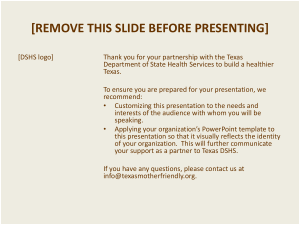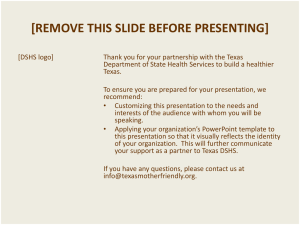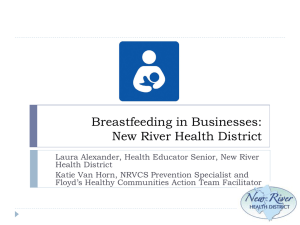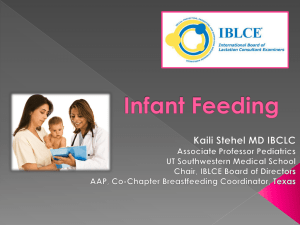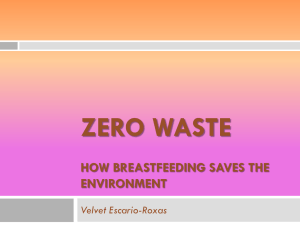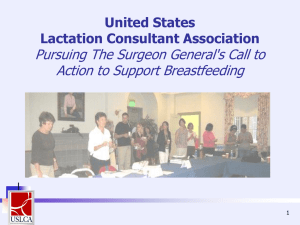- Mother
advertisement
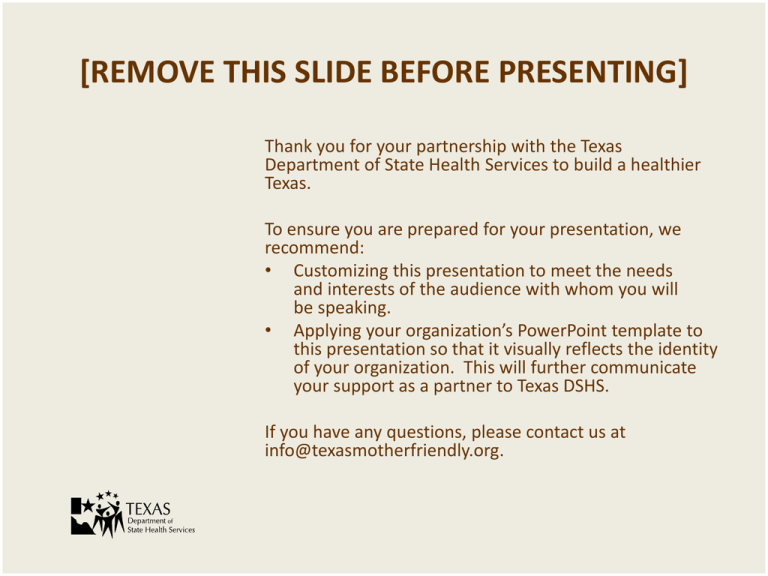
[REMOVE THIS SLIDE BEFORE PRESENTING] Thank you for your partnership with the Texas Department of State Health Services to build a healthier Texas. To ensure you are prepared for your presentation, we recommend: • Customizing this presentation to meet the needs and interests of the audience with whom you will be speaking. • Applying your organization’s PowerPoint template to this presentation so that it visually reflects the identity of your organization. This will further communicate your support as a partner to Texas DSHS. If you have any questions, please contact us at info@texasmotherfriendly.org. [Presenter Name] [Presenter’s title or one-sentence bio] Worksite Lactation Support Programs Building a Healthier Texas THE CASE FOR BREASTFEEDING Breastfeeding Benefits Mom and Baby for a Lifetime • Breastfeeding is the standard for infant feeding and protects infants and children from many significant childhood illnesses and chronic diseases. • The American Academy of Pediatrics and all other health authorities recommend exclusive breastfeeding for the first six months of life and continued breastfeeding for a year or longer. • $13 billion of direct pediatric health-care costs and over 900 lives would be saved annually if 90% of women were able to breastfeed according to medical recommendations. Bartick & Reinhold, Pediatrics, 2010 Breastfeeding Is Good for Babies Breastfed infants have a reduced risk of obesity throughout the lifespan. • Infants who are not breastfed are 32% more likely to suffer from childhood obesity than infants who are breastfed. • The longer and more exclusively a mother breastfeeds, the greater the protection against obesity. • Breastfeeding promotion is a cornerstone of the Centers for Disease Control and Prevention’s obesity-prevention efforts. Arenz S, et al. Int J Obes Relat Metab Disord. 2004. Ip S, et al. AHRQ, 2007. Breastfeeding Is Good for Babies Exclusive breastfeeding reduces risk for: • • • • • • Obesity Ear infections Respiratory infections Asthma Gastrointestinal infections Atopic dermatitis Ip S, et al. AHRQ, 2007. • Type 1 & type 2 diabetes • Leukemia • Sudden infant death syndrome • Necrotizing enterocolitis • And more… Breastfeeding Is Good for Moms • For each 12 months of breastfeeding, the mother’s risk for breast cancer is reduced by 4 percent. • Breastfeeding reduces a mother’s risk of ovarian cancer, type 2 diabetes, postpartum depression, and cardiovascular disease. • Breastfeeding releases the hormone oxytocin, which helps both mother and baby relax and enhances bonding. Collaborative Group on Hormonal Factors in Breast Cancer, Lancet, 2002. Ip S, et al. AHRQ, 2007. Schwarz AG, et al. Obstet Gynecol. 2009; Stuebe AM, et al. Am J Obstet Gynecol. 2009; Levine A, et al. Peptides. 2007; Mezzacappa ES, et al. Health Psychol. 2002. BARRIERS TO BREASTFEEDING U.S Women Achieving Personal Breastfeeding Goals Source: Centers for Disease Control and Prevention, 2007 Infant Feeding Practices Survey http://www.cdc.gov/ifps/results/ch3/table3-35.htm Breastfeeding and Working Moms • • • • • • Women comprise half of the workforce. Four of every ten women are the family’s primary breadwinner. Almost 60% of new mothers returning to work in Texas are unable to reach their breastfeeding goals. Mothers are most likely to wean their infants within the first month after returning to work. Only 10% of full-time working women exclusively breastfeed for six months. Full-time employment decreases breastfeeding duration by an average of more than eight weeks. If a mother chooses to breastfeed, she needs to pump breastmilk during the workday in order to maintain her milk supply. Missing even one needed pumping session can lead to decreased milk production and other undesirable consequences. An Unspoken Need • Many women are uncomfortable talking about their choice to breastfeed or their workplace needs to maintain their ability to continue. • Because employers are not hearing about it from their staff, many employers do not realize that there is a need. An Easy Solution: WORKSITE LACTATION SUPPORT Worksite Lactation Support Definition: Basic arrangements that allow mothers to comfortably express and store breastmilk when separated from their babies during the work day. Simple. Easy. Affordable. Flexible programs can be designed to meet the needs of both the employer and employee. Basic low-cost requirements include: • Scheduling for lactation breaks • Private, clean space, other than a bathroom, to express milk or breastfeed (a dedicated lactation room is NOT required) • Arrangements for cleaning hands and equipment, and for hygienic storage of expressed milk Good for Business Worksite lactation support programs: • Are cost effective, showing a $3 return for every $1 invested • Reduce turnover, lower recruitment and training costs, cut rates of absenteeism, boost morale and productivity, and reduce health-care costs • Are a useful recruitment and retention tool, helping your business to compete for—and keep—qualified employees Good for Texas Employers who support breastfeeding: • Contribute to the lifelong health and wellness of infants and their mothers • Reduce the health-care burden of childhood illness, including reduction in costs and childhood deaths • Ensure a more productive workforce by keeping babies healthy and current employees loyal, satisfied, and able to more fully attend to their work • Contribute to a healthier, more competitive workforce of the future through long-term prevention of obesity and chronic disease Texas Department of State Health Services TEXAS MOTHER-FRIENDLY WORKSITE PROGRAM About the Program • The Texas Department of State Health Services provides guidance, tools, and recognition for employers to establish Mother-Friendly worksite lactation support programs. • Hundreds of Texas employers have already received designation for their worksites. • There are only five basic requirements for designation. Most employers already fulfill some of these requirements. • Designation includes a certificate and listing in the online Texas Mother-Friendly Worksite directory. Texas Mother-Friendly Worksite Minimum Requirements for Designation Have a written employee breastfeeding support policy that provides for: o o o o Flexible scheduling to allow time for milk expression breaks Accessible, private space other than a bathroom Accessible, clean water source Accommodation of milk storage Video provided courtesy of Texas Department of State Health Services. TexasMotherFriendly.org Breastmilkcounts.com SUPPORT A HEALTHIER TEXAS Support Worksite Lactation Programs Be a champion within your worksite. Talk to your employer. Talk to your employees. Develop a worksite lactation policy. Create a worksite lactation program. Serve as an Outreach Partner and talk to other employers. Pledge your support and learn more at TexasMotherFriendly.org.
